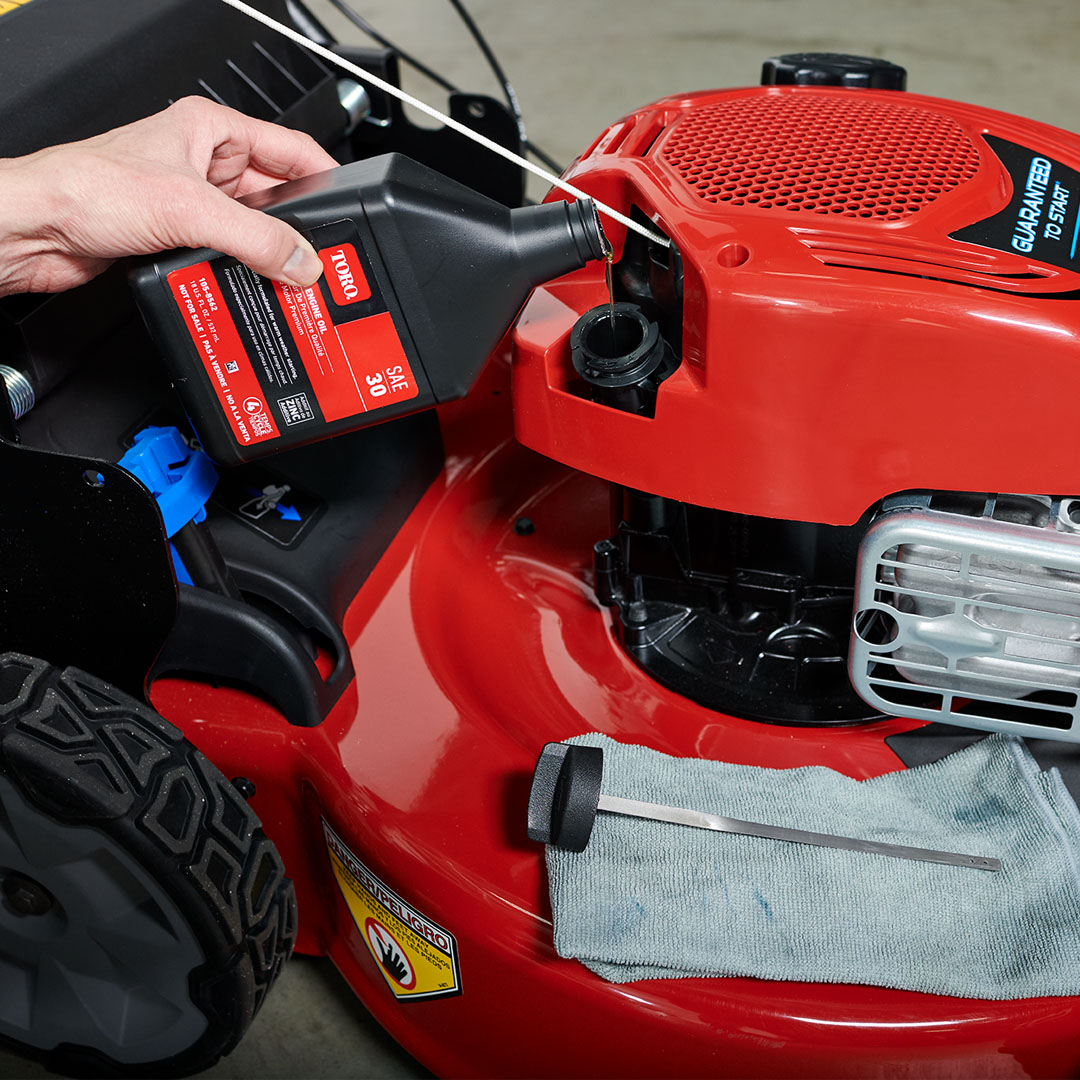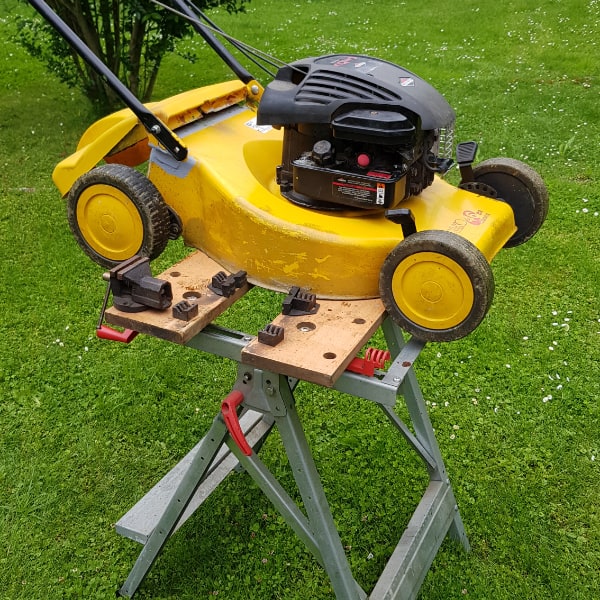Preparing for the Oil Change
Before you start the lawn mower oil change, good preparation is key. It ensures a smooth and clean process.
Warming Up the Engine
Start by warming up the engine. This helps the oil flow freely, making it easier to drain. Run the mower for a few minutes.
Cleaning the Oil Fill Area
Next, clean around the oil fill cap. Use a rag or a brush to remove any dirt, ensuring no debris gets into the engine.
Setting Up the Oil Catch Pan
Finally, place an oil catch pan next to the mower. Position it where you plan to tip the mower so it catches all the oil.
Draining the Old Oil
After preparing your lawn mower for the oil change, it’s now time to drain the old oil. This is a crucial step in ensuring your mower runs efficiently.
Removing the Oil Cap
Start by taking off the oil cap. Make sure your hands and tools are clean to prevent dirt from entering the engine.
Tipping the Mower and Draining
Gently tip the lawn mower to its side, with the oil side down. Position it so the air filter faces upward, avoiding contamination. Drain the oil into your catch pan. If there’s a drain plug underneath, use it to empty the oil more conveniently. Wait until the oil stops flowing, then set the mower back on its feet.
Replacing the Oil Filter (If Applicable)
Not all mowers have an oil filter, but if yours does, it’s vital to change it too. This keeps your mower running well.
Preparing Oil Catch for the Filter
First, put an oil catch container under the oil filter. Make sure it’s right below to catch any spills.
Unscrewing the Old Oil Filter
With the catch in place, gently unscrew the old filter. Let it drain out into your catch container.
Installing the New Oil Filter
Before screwing in the new filter, dab some oil on its seal. This helps it fit snugly. Screw it on firmly, not too tight, just until it’s securely in place.
Refilling with New Oil
Once the old oil has been fully drained from your lawn mower, it’s time to refill it with fresh, high-quality engine oil. This is an essential step to revitalize your mower’s performance and efficiency.
Gradually Adding Engine Oil
Begin by identifying the correct type of oil recommended by the manufacturer for your specific lawn mower model. Slowly pour the new oil into the engine, taking care not to overfill it. It’s better to add a little at a time, allowing the oil to settle.
The amount of oil needed can vary between models, but most require between 2/3 and 3/4 of a quart. Avoid rushing this step; adding oil gradually ensures accuracy and prevents the risk of overfilling, which can harm the engine.
Checking Oil Level with Dipstick
After adding a small amount of oil, pause to check the level with the dipstick. Wipe it clean and insert it into the oil compartment, then remove it again to see where the oil mark is. The correct level typically falls right at the ‘full’ mark, but not over it.
Repeat the process of adding oil and checking with the dipstick until the oil reaches the ideal level. Be patient and precise—accuracy here can save you from engine troubles down the line.
Once you’ve reached the desired oil level, replace the dipstick and secure the oil cap. Your lawn mower is now ready with new oil, ensuring smoother operation and longer engine life. Remember, regular lawn mower oil changes are crucial and should be performed as a part of your mower’s seasonal maintenance routine to keep it running reliably.
Final Steps
Once you have refilled your lawn mower with the new oil, there are just a couple more actions to wrap up the process.
Replacing the Oil Cap
After confirming the oil level is correct, it’s time to reseal the oil compartment. Replace the oil cap carefully and ensure it’s tight. This prevents oil from leaking and keeps contaminants out of the engine.
Disposal of Old Oil
Proper disposal of the old oil is critical for environmental protection. Transfer the used oil from the catch pan into a sealable container. Most auto parts stores accept used oil at no charge. Do not pour it down the drain or on the ground.
Follow these final steps to complete your lawn mower oil change properly. This ensures your mower operates smoothly and remains in good condition.
Seasonal Maintenance Tips
As an all-season gardener or homeowner, it’s crucial to ensure your lawn mower receives regular maintenance. This doesn’t stop at an occasional lawn mower oil change. Following a structured seasonal maintenance schedule can vastly improve your mower’s longevity and performance.
Regular Oil Change Intervals
Just like any well-oiled machine, your lawn mower requires timely oil changes. Most manufacturer manuals suggest an oil change every 20-50 operational hours. However, at a minimum, perform an oil change annually, aligning it with the onset of the mowing season.
For optimal performance of your mower, keep track of the usage hours. Set reminders for oil changes. Staying consistent helps maintain engine health and prevent malfunctions.
Additional Seasonal Tune-Up Tasks
Alongside regular lawn mower oil changes, other tune-up tasks can make a difference. These include:
- Replace or clean the air filter.
- Check spark plugs and replace if necessary.
- Inspect and sharpen the mower blades.
- Lubricate the mower’s moving parts.
- Check tire pressure and adjust as needed.
- Clean the undercarriage to prevent rust and wear.
Executing these additional tasks at the start of each season can enhance your mower’s performance. They also help avoid costly repairs. Remember that a little care goes a long way in keeping your lawn mower running smoothly.
Conclusion
Performing a lawn mower oil change is not just another task on your to-do list. It is a crucial aspect of maintaining the efficiency and longevity of your lawn mower’s engine. By neglecting this vital maintenance step, you risk facing engine problems that can lead to costly repairs or even the need for a complete replacement.
Importance of Regular Oil Changes
Regular oil changes are the heartbeat of lawn mower maintenance. Fresh oil ensures your engine runs smoothly, stays cool, and has a reduced risk of corrosion. It flushes out particles and sludge, which if left unattended, can impair your mower’s performance. Changing oil at the right intervals prevents wear and tear, ensuring that your mower is always ready when you are.
Conducting an oil change as recommended—typically between 20 to 50 hours of operation, or at least annually—can save you from greater expenses down the road. It’s a simple practice that serves as an investment in your lawn mower’s health.
Extending the Life of Your Lawn Mower
A lawn mower oil change does more than keep the engine purring; it helps extend the overall life of your lawn mower. With new oil, the engine is less prone to overheating and more capable of handling the demands of lawn care. Let’s not forget that the engine is the heart of the lawn mower; its care is paramount.
In addition to regular oil changes, other maintenance such as cleaning or replacing air filters, checking spark plugs, sharpening blades, and ensuring all parts are properly lubricated, works collectively to extend the life span of your mower. By diligently following these maintenance practices, you can help your lawn mower operate at its best for many seasons to come.
Regular maintenance is the key to reliability and longevity. It ensures that every time you pull the starter cord, you can trust your lawn mower to perform efficiently and effectively. Remember, a well-maintained lawn mower makes for a beautiful, healthy lawn and a happy homeowner.



